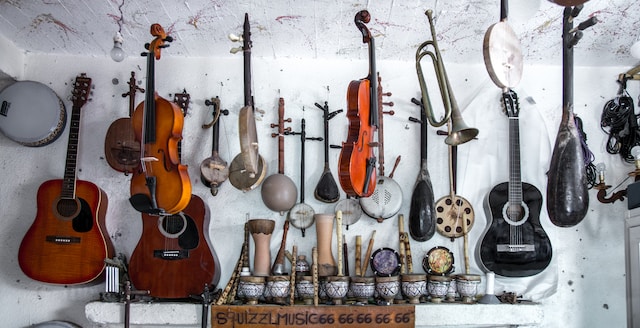If you’re new to playing an instrument, the best options will be those with easy learning curves. Musical instruments can open a world of creativity, expression and emotion you never knew existed!
A ukulele is an easy instrument for beginners to pick up as it has two fewer strings than a guitar and its nylon strings are gentle on fingers. Furthermore, its small size makes it portable!
- Ukulele
The ukulele is a small four-stringed instrument with sounds similar to those produced by guitar. Ideal for beginners, its soft nylon strings do not cause finger pain while its smaller size helps relieve wrist tension. Beginners typically begin playing ukulele by starting with a soprano model – the original and most traditional size of ukuleles – although concert and tenor models may provide more comfortable playing experiences and provide balanced, vibrant tones with increased sustain than soprano models. Once you can strum chords easily, move on to learning some easy songs. Start with campfire tunes like Happy Birthday to You or Kaulana Na Pua; once your fingers “remember” these shapes of chords without looking at charts or fretboards.
- Banjo
The banjo, known for its warm sound and engaging string action, makes an exciting instrument to learn for beginners. There are various playing styles ranging from flat-picking (which Abigail Washburn and Bela Fleck use) to clawhammer. Select a 4-string or 5-string banjo depending on your experience and desired genre of music. Beginners often begin playing on a 4-string banjo tuned to CGDA, the standard tuning used for cellos and violas; when strumming without fretting this produces the G chord frequently used in bluegrass songs. Beginners should focus on learning basic chords at first. Chords are groups of notes that work together to support a melody; once you have this down pat, advanced techniques like rolls can be learned.
- Guitar
Guitar is one of the easiest instruments for novice players to master, offering fantastic sounds while being easy and accessible! Practice is key when learning the guitar; set aside just a few minutes every day and watch how quickly your skills develop! Once you can play basic open chords, move on to power chords – these two-note chords often feature a distorted sound and can easily be moved along the fretboard. Make sure to spend some time familiarizing yourself with the notes of the fretboard (although this may become tedious!). Keep in mind that Rome wasn’t built overnight! Notes closest together can be identified as being either one string lower and five frets right, or higher and five frets left of each other.
- Harp
The Harp is an extraordinary instrument with its own distinct sound. Played with both hands, this distinctive instrument adds elegance and beauty to any musical genre. A harp features 47 strings and is tuned using pedals that raise or lower each pitch class of string pitch-classes, enabling its player to switch keys without manually making changes before each piece is performed. Harps can be played either by striking or plucking their strings, with various sub techniques having an effect on how music is created. Striking techniques tend to be preferred for classical harps as this gives more control over tone and volume of string tone. Harp has featured prominently in many iconic musical scores, from Titanic’s ‘My Heart Will Go On’ to Rent’s ‘Seasons of Love’.
- Recorder
Recorders are accessible instruments with minimal physical requirements that make learning music accessible to children and youth of any age. Plus, they introduce standard musical notation which makes this an excellent introduction for anyone hoping to pursue further study of music later. Oak Meadow provides beginner recorder books which contain simple songs for children to learn quickly (such as Hot Crossed Buns). Practice will likely increase if their progress can be quickly seen (i.e. Hot Crossed Buns). Recorder players typically begin on an alto recorder (using F fingering), as this range contains most solo repertoire written specifically for this range and ensembles often require more of these than descant or tenor recorders. Adults can learn soprano recorders too if desired.
- Bongos
Bongos are an expressive pair of drums used for creating improvised patterns and accent phrasing in dance music and Latin rhythms. Because bongos can be hard on hands, finding a pair with ergonomic handles that reduce hand fatigue is key. Position the drums between your knees with the larger drum in one hand and smaller drum in the other, using your palms on their top surfaces and different strokes of hitting them against their heads to produce various sounds. A simple martillo pattern can help beginners gain better control; experiment with other strokes for more complex rhythms!
- Tambourine
The tambourine is an easy and enjoyable instrument to learn to play, often used to teach children rhythm and keeping time. A part of European folk music for years, today it can also be found across many genres of contemporary music. When playing a tambourine it is best to hold it with your non-dominant hand and use your dominant hand to perform rhythms on it. Furthermore, keeping it at an angle of 45 degrees helps ensure the jingles don’t sound too loudly when you are playing it. Tambourines can be played both handheld and mounted onto a cymbal stand, with more practice you’ll discover a wealth of variations for playing your tambourine – two such variations being thumb roll and figure-8 pattern. When performing thumb rolls you move quickly your thumb over the skin or rim of the tambourine to create a drum roll effect and generate rhythmic rolls that create drum rolls effects.
